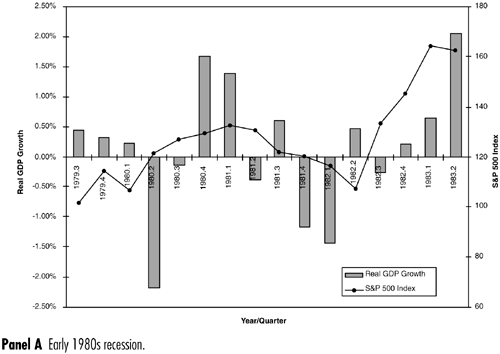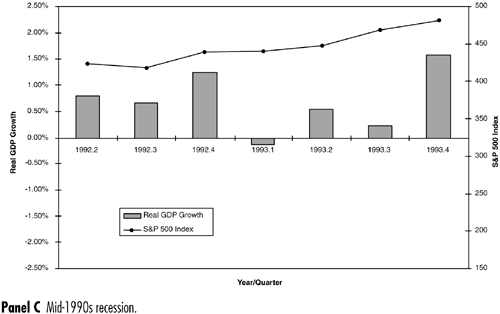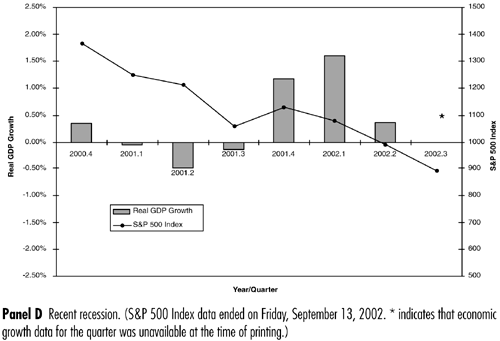Investor Confidence and the Stock Market
| It seems clear that investors lack confidence in the corporate system. However, does this translate into changes in investing behavior? One way to examine this issue is to look at the stock market's performance. We expect the stock market to decline in conjunction with a decline in the economy. In fact, it usually declines in anticipation of an economic downturn. The economy actually did contract in the third quarter of 2001. Since that time, the economy has been growing. Shouldn't the stock market be rising along with the expansion of the economy? The following analysis describes the stock market reaction to the last four instances of economic contraction. Consider the four graphs of the stock market and the economy in Figure 1-2. They illustrate that the bear market in the 2002 stock market is not related to the economy. Each of the four graphs is structured the same. The bar graph shows the real GDP growth rate in the economy in several quarters (the term "real" means that inflation has been removed). The scale for the growth rate is on the left-hand side and is the same in all four graphs. Therefore, the height of each bar is comparable between graphs. The line represents the level of the Standard & Poor's (S&P) 500 Index at the end of each quarter. The level is denoted on the right-hand side of the graph. Since the level of the stock market changes over time, the right-hand scale is not the same among graphs. Figure 1-2. The four figures show the real GDP growth by quarter for the past four recession periods. The level of S&P 500 Index for the periods is also shown. The figure shows the last four times the economy has shrunk for at least one quarter. The period between the second quarter of 1980 and the third quarter of 1982 experienced several quarters of recession. This is depicted in Panel A of the figure. The graph begins with three quarters of growth starting in the third quarter of 1979. Then, in the second quarter of 1980, the economy experiences a severe recession that continues for six months. Note that the stock market anticipates the recession and declines before the recession begins. Indeed, by the middle of the recession, the stock market has predicted the ensuing recovery and has already moved upward. While the recovery was strong, it was also short. By the second quarter of 1981, the economy was shrinking again. Real economic growth was negative in four out of six quarters between the second quarter of 1981 and the third quarter of 1982. The stock market declined through the tough times and again predicted a recovery and started moving up during the third quarter of 1982. The graph ends with three quarters of continued economic expansion. At the end of the three quarters of expansion, the stock market was well higher than when it started three quarters before the beginning of the economic decline. In fact, the S&P 500 Index was up nearly 60 percent from before the recession to after it. The next economic recession occurred in the early 1990s. Panel B of the figure illustrates what happened . The real economic growth rate for the economy was negative in the three consecutive quarters starting in the third quarter of 1990. The stock market declined early in the recession and then rose higher in anticipation of the recovery. Three quarters into the recovery, the stock market had risen nearly 25 percent from its pre-recession levels. The next interruption in the growth of the economy occurred in first quarter of 1993. Note from Panel C of the figure that the economy only shrunk for one quarter and only by a small amount. The stock market hardly noticed the economic decline and continued to rise during the period. That brings us to the most recent period of economic contraction. Panel D shows the economic growth and stock market level around 2001. The real growth in the fourth quarter of 2000 was modest. Beginning with the first quarter of 2001, the economy contracted. However, the recession was small compared to the contractions of the early 1980s (Panel A) and early 1990s (Panel B). The stock market anticipated the decline in the economy and trended downward before it started to decline. The stock market also anticipated the recovery that began in the fourth quarter of 2001. Indeed, the growth of the economy in the three quarters after the recession was large compared to the three previous recessions depicted in Panels A through C. Yet the stock market did not recover. The stock market has continued its decline in the face of the economic recovery. The S&P 500 Index fell to less than 800 in July 2002. Why? If the stock market had recovered as strongly as in previous recessions, the S&P 500 could have been more than 1,500 in June 2002. At the beginning of 2002, Jeffrey Applegate, strategist at Lehman Brothers, forecast the S&P 500 to finish the year at 1,200. Thomas McManus at Banc of America Securities forecast 1,150. Instead, the index was less than 1,000 in June and plummeted to less than 800 in July. The market was down a lot. Why? We argue that investors have lost confidence in the corporate system and that has affected the stock market. Investors have not totally lost confidence. Investors do not appear to be moving all of their money out of stocks. Large masses of employees do not appear to be liquidating the equity in their retirement plans. However, investors seem to be holding back new investment money from the market and a few are getting out of the market. For example, in June and July 2002, there was a net $70.9 billion withdrawn from equity mutual funds. [6] The crisis also seems to be affecting foreigners who invest in the U.S. stock market. Consider what happens when a foreign investor sells his or her U.S. stock. The investor sells the stock in the stock market and receives U.S. dollars. Then, the investor must sell the U.S. dollars and buy the currency of his or her own country. If many people are selling U.S. dollars and buying their own currency, then the U.S. dollar's price will fall. That is, selling of the U.S. dollar will cause its value to decline relative to other currencies. Has this happened? It appears that it has. From February to mid-summer 2002, the U.S. dollar has lost 12 percent of its value against both the euro and the Japanese yen. The lower U.S. dollar will affect your pocketbook. It makes the foreign products you buy more expensive. |
EAN: 2147483647
Pages: 118



